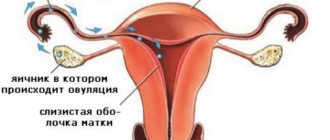Discharge after medical (tablet) abortion
Medical abortion is one of the methods of terminating pregnancy, which is performed in its early stages. If the pregnancy is no more than 7 weeks, the doctor prescribes a medical abortion. This method involves taking a steroid pill, under the influence of which the level of the pregnancy hormone progesterone sharply decreases, which helps to consolidate the embryo in the uterine cavity. Next, the patient takes another “control” drug that promotes intense uterine contractions to remove the rejected fertilized egg.
Discharge after a medical abortion is a normal reaction of the body. These discharges, in their quantity and nature, will most often be similar to regular menstruation, with the exception that the rejected fertilized egg will be released along with the blood. In the case when the discharge after a farm abortion continues for a long time, it can be assumed that the fertilized egg was not fully rejected. Also, prolonged bleeding may be affected by individual intolerance to the medication used to terminate pregnancy, and therefore you should notify your doctor about this. A woman who has had a medical abortion can count on a quick restoration of her menstrual cycle. Regular periods come within 25-35 days (depending on the individual cycle), and ovulation is possible approximately 15 days after the pill abortion.
First aid
If a woman has excessive pathological discharge, she should immediately consult a doctor or call an ambulance. Before the specialists arrive, you need to provide first aid to the patient:
- It is necessary to take a lying position, without sudden movements;
- Apply a cold compress to the lower abdomen, this helps reduce bleeding;
- Create an elevated position of the legs, you can put a pillow or cushion;
- It is not recommended to take medications on your own before the ambulance arrives!
Causes of discharge after vacuum abortion
A vacuum or mini abortion is a procedure to terminate a pregnancy at 6 to 7 weeks. Under the influence of a vacuum, pregnancy ends due to the “sucking out” of the fertilized egg and part of the endometrium. This type of abortion is considered safer for a woman than surgical abortion, because it does not involve the use of metal instruments that can injure the genital tract.
Discharge after a vacuum abortion should appear within 2-4 days, and will be similar to menstruation with the possible presence of clots. Immediately after the procedure, the discharge may be slight and have the scarlet color of fresh blood. About 30 days after a mini-abortion, regular periods come, but their usual cycle may be disrupted due to disrupted hormone production.
Infections and bacteria
After termination of pregnancy, especially if this procedure was performed surgically, the female body's immune system becomes weakened, which makes the body very sensitive to external influences. This condition is extremely favorable for the acquisition of new or development of existing infectious diseases.
Most often, complications appear 3-4 days after the abortion procedure. Therefore, if you notice that the discharge has acquired a yellow color or an unpleasant and pungent odor, then most likely an infection was introduced during the operation. In most cases, this condition is also accompanied by an increase in body temperature.
If you notice at least one of these symptoms, then in order to avoid complications, it is recommended to immediately seek medical help. Moreover, it is not at all necessary to wait for visiting hours with your gynecologist. It is best to call an ambulance immediately, as you may need immediate hospitalization.
I would also like to note that infection during an abortion is not always the result of negligence or insufficient qualifications of the medical staff who performed the procedure. In most cases, the infection enters the cervix, which remains open for some time, later.
The use of synthetic drugs for abortion puts a tremendous burden on the body, which causes a decrease in resistance to the negative effects of infections and bacteria. There is a violation of the vaginal mucosa, as a result, harmful microorganisms easily penetrate the genitals and begin to multiply there quickly. When the uterus is an open wound, it is most susceptible to the development of an infectious process.
Such a phenomenon will definitely manifest itself sooner or later.
Vaginosis often appears as a result of medication or surgery.
Causes of discharge after surgical abortion
Surgical abortion is considered the most dangerous, since it is performed at a relatively long stage of pregnancy (after 7 weeks), it carries a risk of injury and infection. Termination of pregnancy using surgical procedures occurs by curettage of the uterine cavity. The doctor, using special instruments, removes the fertilized egg with adjacent layers of the endometrium.
Discharge after a surgical abortion should normally last from 5 to 7 days. The first couple of days the blood will be scarlet, and a little later its color will become darker and acquire a brown or brownish tint. Heavy, gradually decreasing discharge will be considered normal only if it lasts no more than 10 days. If the bleeding is prolonged and contains clots, then this will be a sign of deep injury to the uterine cavity, the development of inflammation and a reason to immediately consult a doctor. After the woman’s body has fully recovered, her usual periods should begin. This occurs approximately 30-40 days after surgery. Depending on individual characteristics, the menstrual cycle may be disrupted and it will take time to restore it.
Post-abortion condition causes of bleeding
Some patients do not understand why blood appears after interruption using pharmacological drugs. In this case, there is no surgical intervention; the genitals were not mechanically injured, as during a surgical abortion.
However, when pregnancy occurs, the uterus increases in size and the fetus grows in it. Hormone concentrations also change. After an abortion with the help of medications, the uterus returns to its original size, self-cleanses and contracts. These processes cause blood loss.
Brown discharge
Leucorrhoea of this odorless color is normal. However, sometimes they signal the appearance of a polyp in the uterus. A woman’s body after an abortion becomes very vulnerable, therefore, if you have any doubts about your health, it is recommended to consult a doctor.
Scanty discharge, pink or light brown
If discharge does not appear after an abortion, there is a risk that the procedure was unsuccessful and the pregnancy is not completely terminated. If, after a pharmacological abortion, the uterus does not cleanse itself, the doctor may prescribe its completion using aspiration or cleaning.
In some cases, pinkish or brown leucorrhoea appears first in a small amount, which then increases. If scanty discharge lasts for 3-4 days, consultation with a gynecologist is required.
Heavy discharge
Discharge in large volumes may be a symptom of incomplete interruption. In such a situation, the uterus rejects the remains of the fetus, resulting in a large amount of blood and clots.
If discharge with pus appears, treatment in a hospital may be required, since these symptoms indicate the development of tissue sepsis, the disease is considered life-threatening. Inflammatory processes have the same signs. They develop predominantly in women with weak immunity and require treatment.
General information
Having experienced an abortion at least once, a woman will ask questions about how long post-abortion discharge should last and what it should be like. In order not to miss alarming symptoms, every woman should know the characteristics of her body and how long normal discharge lasts after termination of pregnancy.
Moderate bleeding with a small amount of clots will be considered normal. For the first couple of days, bright red and scarlet color of the blood is acceptable, but after that the blood released should darken and, after 4-7 days, gradually give way to colorless, scanty discharge. If bleeding continues for more than 10 days, this will be a sign of danger, indicating the presence of serious wounds or inflammation in the uterus.
Factors on which the duration and abundance of discharge may depend:
- The period of pregnancy during which the termination was performed (The longer the period, the heavier the bleeding).
- The patient's tendency to blood clotting.
- Age characteristics.
- Strength of the immune system and overall health of a woman.
- Gynecological diseases and neoplasms in the genital organs.
- Previously experienced abortions (frequent abortions can cause heavy bleeding due to poor healing of the uterine cavity).
- The experience of the doctor performing the abortion and the qualifications of the clinic.
In cases where, some time after an abortion, a woman experiences pain, fever and other unpleasant symptoms in the abdominal area, accompanied by yellow and foul-smelling discharge, urgent and immediate hospitalization in a medical facility is necessary. The listed symptoms can be caused by a serious infection (including purulent) in the uterine cavity.
Post-abortion condition: causes of bleeding
Often women do not understand the reasons for the appearance of discharge after an abortion, especially a medical one. Indeed, in the first case, there is no surgical intervention or medical manipulation. The fact is that with the onset and course of pregnancy, the uterus grows and increases in size several times as the fetus develops. During this period, the mother's hormonal background changes. After an abortion, the uterus returns to its normal state and regains its original size through contractions and self-cleaning. This process causes bleeding. At the moment of greatest muscle contraction, the amount of blood reaches its maximum.
In rare cases, after expulsion of the fetus, white discharge from the mammary gland is noticeable without pregnancy. With the onset of pregnancy, the level of the hormone prolactin increases in the female body, which is responsible for milk production and prepares the mammary glands for the upcoming lactation. After an abortion, they remain enlarged for some time and colostrum may be released. This is mainly observed after an early abortion.
Even more interesting:
Effective injections for prostatitis
Is duphaston a hormonal drug?
Scanty discharge: pink or light brown
If there is no discharge the next day after an abortion, this usually means that the procedure was not effective and the pregnancy was not permanently terminated. Statistics show 7% of cases of this phenomenon.
If we are talking about a failed pharmaceutical abortion, then it is completed by vacuum aspiration or cleaning. A mini-abortion is completed by curettage.
However, do not panic ahead of time, sometimes the discharge makes itself felt after 2 days. At first it may be a slight pink or brown discharge, but with each passing hour its intensity increases. If scanty discharge continues for more than 3-4 days, then the uterus is not cleansed and you need to inform your doctor about this.
The intensity of the blood released may be insignificant during an early abortion (2 weeks), which does not always indicate pathology.
Heavy discharge
Excessively abundant discharge can also indicate incomplete interruption. In this case, the uterus tries intensively to reject the remains of the fetus, resulting in a large amount of bloody or dark brown discharge and clots.
It happens that dead cells from the remains of the embryo provoke sepsis of nearby tissues. Heavy bleeding is accompanied by purulent mucus, an unpleasant putrid odor, nagging pain in the lower abdomen, radiating to the side and back, increased temperature and deterioration of the general condition. If such symptoms are detected, urgent hospitalization is necessary to preserve the health and life of the woman.
Inflammatory processes have similar signs. The open wound that is the uterus after any abortion is at risk of attack from outside pathogens. The chances of infection and inflammation increase due to reduced immunity and stress experienced by the body. They are characterized by painful bleeding and spasms, fever, chills, and malaise. Inflammations require immediate treatment, as they sometimes affect nearby organs.
What happens a week after an abortion?
The first week after termination of pregnancy is the most difficult for a woman. The patient's hormonal levels change and metabolic processes are disrupted. This affects overall well-being and psychological state. After the procedure, a woman may feel weakness, pain in the lower abdomen, she may be bothered by shortness of breath, heart rhythm disturbances, and nausea. Weakened immunity and massive blood loss lead to anemia, hair loss, and exacerbation of chronic diseases.
Hair loss
Labored breathing
Nausea
What happens 3 weeks after an abortion?
The third week of recovery is normally characterized by a retreat of symptoms. The pain in the pelvis goes away, and spotting becomes rare or stops altogether. Three weeks after the procedure, the woman begins to return to her normal life. Sexual life can begin as early as 2 weeks after medical abortion and 3 weeks after vacuum aspiration. But it is better to refrain from visiting public baths, saunas, and ponds for at least a month.
If, 3-4 weeks after termination of pregnancy, the patient develops unpleasant symptoms, this is an alarming signal. Only timely diagnosis will help identify complications at an early stage and get rid of pathologies. You can get a consultation and comprehensive diagnostics in St. Petersburg at the medical office on Zanevsky Prospekt.
MAKE AN APPOINTMENT
Abortion and contraception clinic in St. Petersburg - department of the medical gynecological association "Diana"
Make an appointment, tests or ultrasound via the contact form or by calling +8 (812) 62-962-77. We work seven days a week from 09:00 to 21:00.
We are located in the Krasnogvardeisky district, next to the Novocherkasskaya, Ploshchad Alexander Nevsky and Ladozhskaya metro stations.
The cost of a medical abortion in our clinic is 3,300 rubles. The price includes all pills, an examination by a gynecologist and an ultrasound to determine the timing of pregnancy.
Bleeding
Bloody discharge 2 weeks after an abortion is an alarming sign that requires consultation with a gynecologist. Bleeding is possible due to trauma to the uterus, vascular damage, incomplete cleansing, endocrine disorders, or infection. If the cause of the bleeding 2 weeks after the abortion is the remains of the fertilized egg, the doctor will definitely prescribe repeated curettage of the uterine cavity.
An unpleasant smell of discharge and an increase in temperature appear during the inflammatory process and the development of an abscess. Additional signs of complications:
- nausea and vomiting;
- dizziness, fainting;
- blood clots in urine;
- blood in stool;
- general weakness.
Dizziness
Girl vomiting
Weakness in the body
After a medical abortion, scanty scarlet-colored bleeding may persist after two weeks. This is due to the body’s different reaction to the action of the pills, especially if the woman has previously taken non-steroidal drugs. In some cases, discharge after medical abortion continues until the onset of the first menstruation. 2 weeks after the medical abortion, there should be no clots, residual tissue, or placenta particles in the discharge.
Recommendations
It is recommended to avoid physical activity, overexertion, and get more rest. Do not use tampons during bleeding, as they can provoke stagnation and the development of an infectious process in the uterine cavity.
Avoid sexual intercourse for a month after bleeding stops. and remember that the best way to avoid unwanted pregnancy is protected sexual intercourse. The gynecologist will help the patient choose individual protective equipment.
https://youtu.be/mFypXlxGDkM











